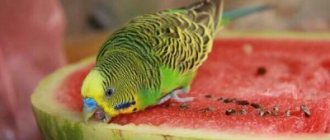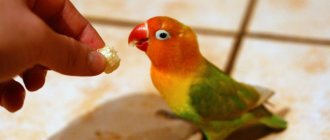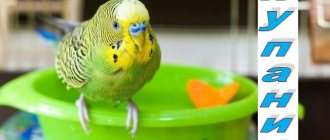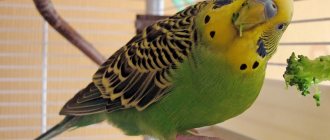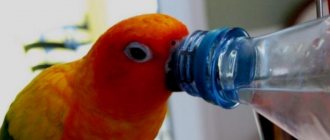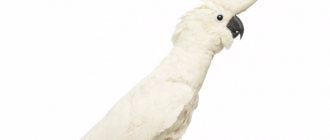Authors: Ivan and Ekaterina Pronin Published: 04/07/2012
Goldfinch. Age 7 months.
Thanks to its characteristic color, the goldfinch cannot be confused with any other songbird. A bright red muzzle and lemon-yellow stripes on the wings, white dots on the black wings and tail - such a variegated color can be called literally exotic.
Goldfinches quickly settle into a home and cage and can become quite tame if you have the patience to tame it.
Goldfinches have a terribly quarrelsome character and can fight over one feeder, even if there are two or three feeders. Therefore, housing two goldfinches in one cage is not the best solution.
General characteristics and appearance
This representative of the finch family is a relative of the familiar sparrow. Ornithologists know that this name unites a large number of lines, among which greenfinches and redpolls, linnets and even siskins stand out. But the most common species remains the common goldfinch (aka black-headed). It is even smaller in size than a sparrow: an adult grows to 10, maximum 12 cm “from beak to tail,” and this with a weight of only 17-20 g.
Such a fragile build is compensated by his appearance. The bright red color of the front of the head contrasts with the white cheeks and the black tone of the back of the head with the crown. The beak is red and white, with a black tip and dark “whiskers” at the base. It is noteworthy that in adult birds in this area you can see a red ring, while in young birds there is no such decoration due to their age.
Important! Unknowingly, the goldfinch can easily be confused with the American siskin and other related species. When purchasing, be sure to pay attention to the red fragments in the design of the head - they indicate that this is a goldfinch.
The abdomen is reddish-brown (less often brown) and is similar in color to the chest. The white rump looks impressive against the background of a black tail with white specks. The wings stand apart - they are yellow (according to the color of the transverse stripes), and in their rear part there are alternating black and white small spots. Such a handsome man rests on his dark yellow, almost brown paws. Having found out exactly what the song goldfinch looks like, it is logical to ask how it behaves in nature.
Habitat and diet in the wild
Wild individuals inhabit deciduous groves and gardens of Europe and Western Siberia, Western Asia and North Africa. At the same time, the bird prefers relatively open areas - you are unlikely to see it in a deep forest (unlike a sparse planting or even a city park). They are considered a sedentary species, although they are capable of migrating over long distances. They often leave their nests to search for food together (flocks of goldfinches are frequent guests of summer cottages and fields).
In April they split into pairs, and by the beginning of summer, nests built from various roots connected by cobwebs are visible on the tree crowns. Around this time, transparent green eggs with red spots on the blunt edge appear in the nests. On average, each clutch consists of 3-5 eggs.
Did you know? Sparrows can be considered the smartest birds, if we take only the ratio of total weight to brain mass. It is estimated that out of 100 g of total weight, the brain accounts for 4.5 g.
The female incubates them for about two weeks and feeds the offspring with aphids or small larvae for the same amount of time. At the age of 15-20 days, the chicks try to leave the nest, but not for long (they are supported by their parents for up to a month).
Find out more about keeping such birds as: siskin, crossbill, canary, necklace parrot, budgerigar, kakapo parrot, cockatiel, gray gray macaw, rosella, amazon and black raven.
The basis of the diet of an adult bird is the seeds of grasses, shrubs or trees. They love achenes of burdock, horse sorrel and thistle. They do not refuse worms with larvae, although this is more “baby food”. The question of what the free goldfinch eats has another solution. If there is a sparse supply of seeds in the chosen place, birds without any problems switch to eating the leaves and stems of small weeds.
Bird walking
It is vitally important for the bird to be allowed to fly, and the point here is not even that it is boring when locked up, but mostly in nutrition.
Since goldfinches eat a lot of fat, they are susceptible to obesity, and this problem can be avoided using two comprehensive methods: give more greens, vegetables and fruits, and be sure to walk the bird. The goldfinch in the photographs in this article is not locked up at all, but comes to spend the night in the cage on its own, voluntarily, except in cases of hooliganism.
In an apartment, goldfinches, unlike robins, prefer to fly and sit higher: on tables, cabinets, and chandeliers. This is explained by the fact that in nature they prefer to live higher in the tree. If you have a large mirror in the room where the goldfinch lives, then most likely he will hang around it. And the garbage will be where the goldfinch will spin.
It is naive to think that it is enough to lay down a newspaper and shake off the garbage from it. In this case, the newspaper will become the main source of garbage. Our goldfinch’s favorite pastime is gnawing, tearing and littering; he devotes all his time to this activity during the “walk.”
How the goldfinch sings
The singing of this bird, coupled with its bright color, determined its popularity among numerous owners. Experienced owners, together with biologists, claim that the goldfinch is able to produce more than 20 variants of melodies, in terms of euphony, not inferior to the repertoire of canaries. It all depends on the pet’s mood: a well-groomed bird will delight the ear with high-speed chirping with elements of whistling. Such improvisations can last for hours, especially in the spring.
Important! The goldfinch willingly copies motifs heard from other birds. But when keeping several varieties in one house at once, interest in their neighbors may after a while give way to bad mood and apathy - for this species it is important to be the center of attention.
It is also possible to switch to more monotonous and rough trills if the bird is left alone for a long time and does not receive the necessary attention from its owners. Singing has traditionally remained the activity of males, although some females are superior to them in this regard. But during molting, sexual differences fade into the background - during this period, goldfinches are simply silent, taking a “creative break.”
Is it worth keeping at home?
Having confirmed the artistic inclinations of this species, many immediately get excited about the idea of having this feathered miracle in their apartment. But before that, it is advisable to soberly weigh the pros and cons of such cohabitation.
pros
Let's start with the advantages. These include:
- bright appearance;
- beautiful trills that can be listened to almost all year round;
- natural intelligence and innate curiosity;
- the bird's sociable disposition;
- fast learner;
- unpretentiousness in nutrition and maintenance.
Here you can add such a factor as the small size of the bird, which will be a powerful argument when it lives in a small room.
Minuses
There are also disadvantages that should also be kept in mind:
- a specimen caught in a nearby field is unlikely to give concerts and be willing to make contact - it is best to purchase an individual at a pet store;
- Individuals of different sexes do not get along very well when kept together - this is fraught with permanent stress. In such conditions, one can forget about singing and offspring;
- chicks, already separated from their parents and living in the same cage, often become competitors (mainly for food), which can lead to fights and injuries.
Did you know? Hummingbirds are unique not only for their miniature size - they are the only bird that can confidently fly both forward and backward.
If you are sure that such difficulties will bypass pets, you can safely get birds.
Optimal Cage Size
Vladimiroff , Albina , Dipperman , Saturday evening, or rather deep into the night, I had some free time and for the first time I carefully went through the topic from “A” to “Z”.
I don’t know what “defect” of thinking I have, but I absolutely agreed with everyone. Each participant, from my point of view, was right, although essentially they stood in opposite positions. Maybe that's because. that we know little about each other and those goals. which we follow in keeping birds. Although I am sure that everyone loves them (otherwise why would they devote so much free time, effort and money to them). My first book I read about birds was Boehme. A link to the cell sizes of this author was given here. I remember how I re-read these sizes in childhood (somewhere in grade 3-4. How important it was for me that these sizes were smaller: it was difficult to buy a large cage in the early 60s, and my parents resisted my hobby in every possible way. This is now theoretical you can buy mansions, and in those years Khrushchev-era buildings were just appearing and people stood in line for 25-30 years for an apartment. We had 5 people living in one room. How about a large cage, and even a closet for 60 birds? The first cage was long 30 cm and then borrowed. But I was overly happy looking at my pair of redpolls - the first songbirds. I even remember that the man took pity and sold them to me for 80 kopecks, saved at breakfast. In the presence of the family, fully assembled, the bird could have been in a cage, but when the adults were at work, my birds flew around the room like Albina’s bluethroat. That is, such a cage has a right to exist. I really trust Noskov and his team, who recommend a cabinet for 60 birds, occupying a minimum places In “production” (!!!) with limited space. But here people are doing science and trying to create satisfactory conditions for their wards. everyone understands. what a huge number of birds. that they bred did not live in this locker and not on a long-term or permanent basis. And experiments are important for science even if the result is negative. It is quite acceptable and useful to compare the morphological and physiological state of birds that have lived for a long time in a cage and in the wild (Dipperman), and for this it is not necessary to kill two goldfinches to obtain accurate data: free ones die when caught (even a minimal percentage); those who have lived for a long time in the wild also die cell, even if by our own death from old age, we will not take into account various accidents. I agree with (Dipperman) that a rare species can be bred by just 1 industrialist. but no less important is the disappearance of birds from human economic activity, which Vladimiroff insists on. Moreover, there is a massive death of many individuals and species of birds at once. It can be difficult to fight the first ones. but it’s possible, but what to do with officials, etc., who stir up psychosis in the press or make politics and business out of it under the guise of noble concern for people?!! Or allegedly, out of ignorance, using pesticides or herbicides in agriculture, from land reclamation or dam construction, from diverting rivers? We need to approach everything wisely, and before getting a bird at home, we still need to understand ourselves and find out what I want to get in return from this keeping. (I would like to make a reservation right away that purchasing a bird for 2-4 months and then releasing it is generally inadvisable. But mentally keeping it with you forever, when the loss of some of the skills necessary for survival in the wild is not so important for it, you must strive to create ideal conditions for it , so that the bird reveals itself to the maximum in all its beauty, habits, as Albina suggests.) If a friend for communication, then probably a parrot. small ones can be released into the room without any problems. This could be many of our birds, large and small, especially young birds. If for the sake of beauty, then there can be several of them in even one cage (the most elegant among granivores). The food is mostly common. The more variety of seeds, the better. Although here you can find negative aspects (competition at the feeder). If you are interested in singing, then you definitely need to get insectivores, and keep each bird in a separate cage. Considering that we are not talking about an aviary as an unaffordable luxury, but only keeping birds in a cage in an apartment. then how many of them can there be? And when they all sing at the same time, it’s just a continuous cacaphony of sounds, there is no opportunity to admire the skill of an individual singer and truly appreciate his skill. If the bird is kept in a cage on a permanent basis, the minimum length should be at least 50cm for small birds. It seems to me better to keep 3 small granivores in such a cage than one in 3 38cm cages, as Boehme suggests for the siskin. You need a cage 70-80cm long for birds like blackbirds. The cage should be comfortable for the birds, i.e. functional. Essentially made to order. Because now on sale there are mostly imported ones with all sorts of Gothic domes (I would force the authors of these cages to wear them in winter and summer instead of a headdress). The cage for a wagtail and a nuthatch, with the same volume, should also be different, I think this is clear to everyone and is beyond doubt. Modified on March 26, 2006 by Vladimir
Conditions for keeping at home
If you are interested in how to properly care for a goldfinch living at home, you can see that there is no particular difficulty here. Although there are still some nuances.
Choosing and arranging a home
It all starts with selecting a cage or enclosure. The minimum size of bird housing is 50x30 cm (although it is better to take a cage with a reserve). Another mandatory requirement is the presence of at least two levels, because an active pet needs more space. Pay attention to the tray at the base - it should be smooth, without cracks or burrs that can injure the bird.
Study the singing characteristics of budgerigars and teach them to speak.
The distance between the rods also plays a role: this interval should be within 1-1.5 cm.
A larger gap carries the risk of injury. In addition, this way the goldfinch can escape from its refuge, or a curious cat will stretch its paw there.
In addition to the hanging feeder and drinking bowl, even before moving in, you will have to install swings and perches inside - nimble individuals require a full-fledged play area. Having a small pool will only be a plus. The cage for the domestic goldfinch is placed away from direct sunlight and drafts. At the same time, it should be well lit. Important! Make sure that the perches are smooth - a knotty surface can lead to irritation on the paws, which leads to more serious consequences such as pododermatitis.
Normal room temperature is suitable. Try to avoid two extremes in terms of air - both dry and humid air will be dangerous to the health of birds. For these reasons, the cage is placed away from switched-on batteries or damp corners.
How many goldfinches are best kept in one cage?
Ideally, each bird has a separate cage. Cohabitation of two active individuals (especially a male and a female) almost always leads to domestic conflicts. The initiative usually belongs to the “female” half of the population - the female tries to monopolize everything, from food to free space. Against this background, her partner risks falling into apathy, which is immediately evident from his stubborn silence and shaggy appearance.
It will be interesting to find out what you can feed parrots, how to prolong their life, and establish relationships with them.
The situation with chicks is almost the same. It happens that the offspring turned out to be too numerous, and the owner simply does not have so many cells on hand. One way or another, this problem will have to be solved immediately, by temporarily placing no more than two representatives of the same generation in one large cage. Naturally, with such a development of events, there should also be twice as many drinking bowls, feeders and ladders, otherwise division will begin. But it is not worth prolonging such cohabitation over time - as active birds grow, sooner or later they will upset this fragile balance.
Cleaning the cage
Daily cleaning comes down to replacing water (both for drinking and bathing), changing food and removing scattered particles.
Did you know? Birds of prey, unlike many more peaceful birds, are monogamous - a pair is chosen once and for life.
General cleaning is required once a week:
- perches are cleaned with disinfectant solutions that are safe for birds;
- the feeder and tray are washed with a mild detergent;
- They also treat all remote corners of the cage and bars where parasites can hide;
- in the end, all this is washed off with running water, and the cage is left to dry (2-3 hours in the fresh air will be enough).
In general, the procedure is well known to everyone who has dealt with birds.
Flying around the room
While the cleaning is being done, the goldfinch is released to stretch its wings: on average, 10 minutes a day will allow you to maintain physical shape. Before releasing it, make sure that the doors and windows in the room are securely closed, and that there are no other animals nearby for whom the chick cutting through the air could turn out to be a real target or even dinner.
Check out the best talking parrot breeds.
It is better to remove sharp or heavy objects from the table and other surfaces - a curious bird may become interested in them, causing injury to itself. The same applies to open containers with boiling water and hot dishes, cosmetics or household chemicals, for example, powder.
Cell and its location
The goldfinch cage is a standard design, suitable for almost all songbirds of a similar size. The goldfinch is an active bird and loves to gnaw on grain or seeds on a perch, so a high tray is required to prevent husks and other debris from flying out of the cage. The cage should not be overloaded with perches, swings and toys - the bird will find a toy for itself. Three perches are enough: two at the bottom at almost the same height and one on the second tier, preferably some kind of Y-shaped spear attached to the back wall of the cage. The perches must be placed so that the birds do not touch the side walls of the cage with their tail in any position. The perches should be of such a diameter that the bird’s foot covers no more than 2/3 of the circumference, that is, so that the bird’s foot does not close on the perch.
We also do not recommend hanging a mirror. The goldfinch is a narcissist, he can look in the mirror all day long, fight or be friends with him, but in this case it will not be easy for you to get his attention.
It is better to place the feeder at the bottom of the cage, equidistant from the perches, so that poop and other “joys” do not fall there. We have a hanging drinker, installed inside the cage, and attached to the perches.
The back and side walls, as well as the ceiling of the cage, should be made closed, made of bakelite plywood. The open part of the cage is only the front. For rods, you can use either high-carbon steel wire or bamboo (for barbecue) sticks, of which there are a dime a dozen in stores.
- The main dimensions L x W x H are within the range of 550 x 350 x 400 mm;
- tray height – 150 mm;
- rod pitch – 15 mm.
A clear example of a cell.
When kept at home, the bird does not receive one very important thing - ultraviolet radiation. Window glass absorbs the near UV component of sunlight. To compensate for the lack of ultraviolet radiation, it is necessary to use special lamps.
The photo above shows the Arcadia Birds Lamp FB18.
In summer, it is enough to place the cage with the bird near an open window. Ultraviolet light also passes through clouds in sufficient quantities. In any case, sunbathing is a necessary procedure for birds, regardless of whether there is a UV lamp or not.
When using such a lamp, you need a certain lamp, with an electronic ballast (electronic ballast), and not with a classic choke.
Equally important is the correct regulation of daylight hours, since many processes in the bird’s body depend on this. The main thing is that the daylight hours are as close to natural as possible. That is, if you leave for work at 7:00 in the winter and come at 18:00, then you will not be able to turn on and then turn off the lamp at the right time. To solve this problem, you can and should use a digital timer, for example, BND-50/SG3, or EWD-EG03, or any other.
Now about cage placement
.
Put it on a shelf or hang the cage on the wall – it’s your choice, there’s nothing to say. But the place must be chosen so as to provide natural lighting even when using special lamps.
The absence of drafts is very important! Draft is one of the main enemies of birds.
The height of the cage should be chosen so that the top perch is at eye level, which will ensure easy access to the cage and peace of mind for the bird.
It is worth remembering that even with the best cage, a bird was born to fly.
What to feed the goldfinch at home
Breeding any animals, including goldfinches, in standard home conditions is unthinkable without a properly composed menu.
Important! Birds should not be indulged in sweets - a piece of candy or chocolate grabbed on the fly will cause serious stomach upset.
In the case of these birds, the diet consists of:
- ready grain mixture. It is made from equal parts of millet and burdock, rapeseed and dandelion. You can add sunflower and hemp with plantain to them. But achenes of coniferous trees (pines and spruce) are already for gourmets: not all birds accept such ingredients;
- live food in the form of ant pupae and mealworms. They are given in the amount of 4-5 pieces per day. Although worms are also considered a delicacy not for everyone (while pupae are loved by everyone);
- wet “chatter” and cereals for insectivores. They are fed 2-3 times a week;
- a special delicacy - a salad of finely chopped and hard-boiled eggs, grated boiled carrots and pieces of crackers. This mixture is very useful for adults.
Feeding frequency: at least 2 times a day, in equal, medium-sized portions. The “supplement” is allowed as an exception, and only for sick or weakened birds (it cannot be given regularly).
The tame goldfinch Konstantin is simply handsome!
Today we will continue the conversation with Tatyana, who told us the story of two baby rats Bobby and Nikki, surrounded by care in her hospitable home, where they also live: the pug Quinty, the cat Morty, the parrot Pea and a tame goldfinch named Konstantin (which means “permanent”) ) This is exactly the bird our report is about, and for details, you are welcome on Instagram: @kvintiimorti, @_littlebobby and Kostya’s personal TikTok account: @bird_konstantin
– Tatyana, hello again! As we promised our readers, today we will continue our conversation about your amazing tame goldfinch Konstantin. But first we would like to remind you about all your pets, here they are:
Photo: @kvintiimorti / Instagram
- So, Kostya. How did you get it?
– We got Kostya in June last year. We were relaxing at the dacha with our entire large family (a cat, a dog, a parrot and 2 rats), and I noticed that our cat Morty had been sitting under the house for a long time and was looking at something. I was sure that it was either a beetle or a lizard. Curiosity got the better of me and I went over to take a look. My surprise knew no bounds when I saw a fluffy little ball with beady eyes) Our cat is a “hunter” and it was surprising that he didn’t touch him, perhaps because the chick froze, and the cat was waiting for him to move to grab.
Photo: @kvintiimorti / Instagram
When I took the chick in my hands, he didn’t even move. I didn’t find a nest, and there were no birds nearby, and neighbor’s cats often come into our territory, so it was decided to take the chick home.
Unusual bird feeders or how good things come back with joy
– Tanya, it must have been difficult to feed such a small chick? Was this your first experience?
– Yes, I had never worked with birds before, especially since the chick was very tiny. I read on the Internet how to make formula for feeding and realized that I would not find these ingredients at the dacha. It was decided to return home.
Video: @kvintiimorti / Instagram
The first time feeding was difficult, the chick was very weak, its beak did not want to open, it had to be force-fed. The next morning it was scary to look into the carrier, because it was not clear whether he was alive? But everything was fine and each time it became easier to feed the chick, and on the second day Kostya himself began to open his beak and away he went!
Add to cart
Quick view
Compare
Close
PADOVAN OVOMIX GOLD Giallo complex egg food for chicks
600,00 ₽
Video: @kvintiimorti / Instagram
She fed every 1-1.5 hours - from 6 in the morning until 9-10 in the evening, and this was the case for a month. I felt like a nursing mother, Kostya awakened maternal feelings in me). He ate and immediately after eating he fell asleep in his arms, it was so cute!
- Yes, it was a difficult time for you. You couldn't leave the chick for a minute, could you?
– This month we took Kostya with us everywhere), so he got used to traveling by car and now he calmly, without stress, travels with us, this is how Kostya rides in the car. We can say that the bird has become an avid summer resident and traveler!
@bird_konstantin
Travelers



